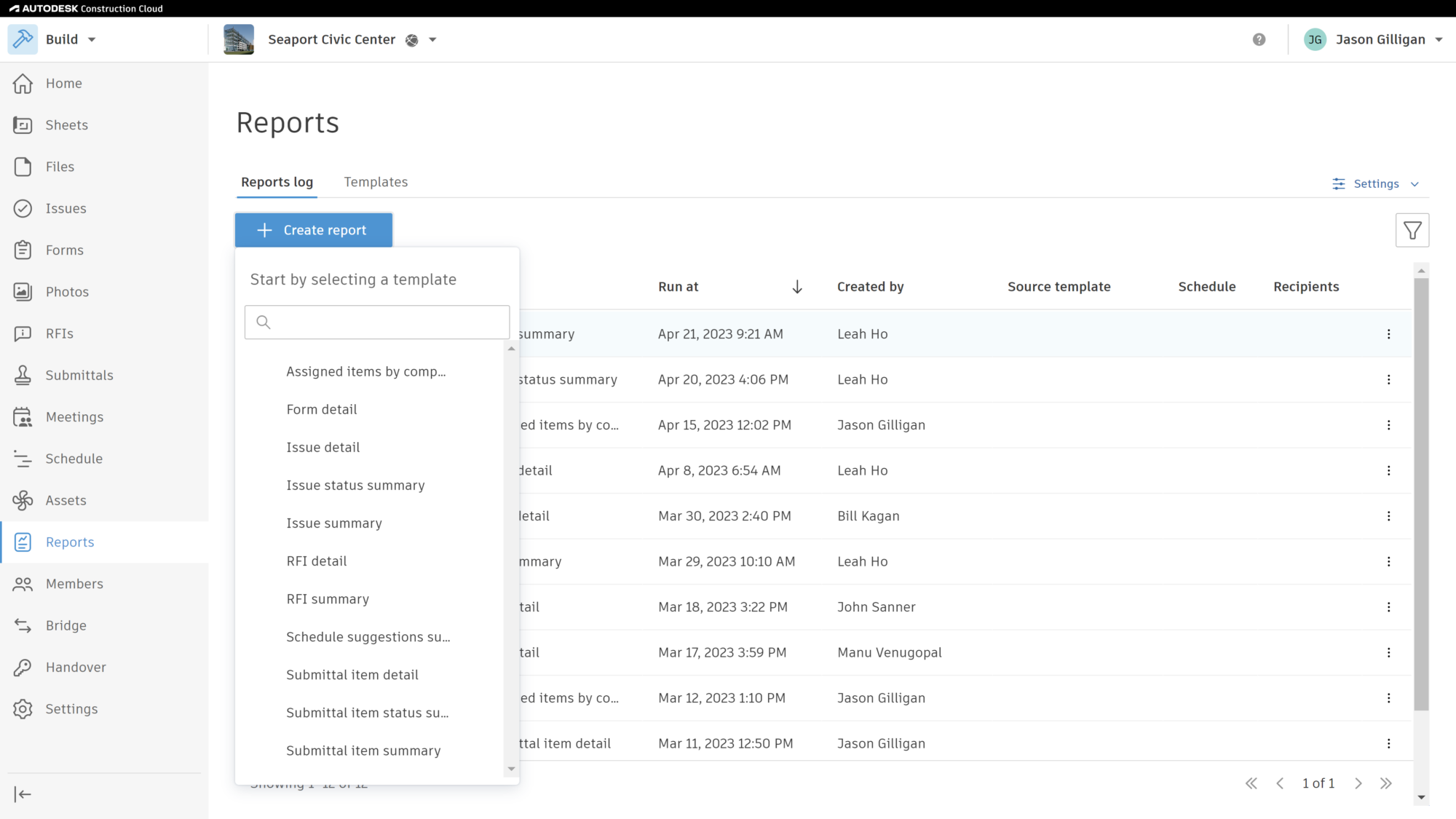In virtually all industries,documentationis critical to track progress, illuminate discoveries, and provide information to others. Nowhere is this truer than in the case of construction with daily reports. These routine reports are an essential process in construction, especially as it is an industry that relies so heavily on documentation. In a typical daily report, the sum total of work performed on any given day is thoroughly chronicled, providing a snapshot of what occurred.
Bottom line: documentation is critical in the building industry. Daily construction reports can save construction companies legal trouble, underline professionalism, and elevate projects from good enough to excellent, with all the success that implies. So today, let’s dive into what makes a good daily report, what doesn’t, and how to take your field reports on your project to the next level.
What we discuss:
- Basics of daily construction reports
- What’s included in a daily report
- Why daily reports are important
- Why daily reporting can fail
- Tips to improve daily reports
- Daily reports template
The basics of daily construction reports
Before learning more about how to perfect reports, let’s first dive into the basics of daily reporting in construction.
So what is a daily construction report?A daily report is an essential construction document that reports a summary of the daily and sometimes hourly conditions and activities at a jobsite. The report is typically prepared by project admins and is a record of who was on site, what equipment was used, and the exact times work started and finalized. A daily report also notes project progress, weather events, and any safety incidents. The documentation is critical for serving as support and evidence in any case of conflicts or disputes, and it also reports if work was not performed that day in the case of a no-work day or event.
一般来说,日常的报告是一个协作的努力t. A general contractor depends on subcontractors to provide the information for daily reports, and often superintendents and foremen are responsible for editing them. Ultimately, though, the project manager is generally the one who reviews and signs off on reports before sending them out to administrators, owners and other high-level stakeholders.
What’s included in a typical daily report?
While daily construction reports differ depending on the company creating them and the desires of the administrators overseeing the project, a thorough write-up includes the following elements:
Report Date
For future reference, a date is critical. Even when one day’s report looks much the same as the previous, it’s absolutely imperative you be able to distinguish them in future, especially if a conflict arises.
Worker Information
It’s essential to have an accurate picture of the number of workers on site that day and the number of hours they worked.
Available Resources
The materials, equipment, workers, subcontractors, contractors, inspectors, superintendents, administrators, client representatives or other staff members are critical elements of the overall picture.
Weather Conditions
Weather matters hugely to construction productivity and timelines. Rain, temperature, wind speed and other outdoor factors affecting conditions are critical notes to include in reports.
Physical Conditions
Include any on-site factors that might influence the quality or timeliness of the work.
Risks and Safety Incidents
Both the unrealized risks and the actual accidents or safety violations are crucial to your later understanding of what happened that day. Also, accurate reporting when things go wrong is just as important as when they go right, or an opponent may blow the scenario out of proportion later.
Disruptions and Delays
These are an unavoidable part of the construction industry. It’s better to acknowledge them and what caused them upfront rather than trying to sweep undesirable circumstances under the rug.
Other Information
Your company may also require additional details, such as what technology you used, important communications between team members or changes in project scope. If it’s relevant to the project and its outcome, it’s better to include in the daily construction reports than not.
Why are daily field reports so important?
Daily construction reports serve many critical purposes. Prime among them are their roles in legal disputes, specific claims, and project team documentation.
They serve as legal documentation
According to Plan Academy,the most common causes for global construction disputeswere “failure to administer the contract, poorly drafted or incomplete and unsubstantiated claims, failure to understand and/or comply with its contractual obligation by the employer/contractor/subcontractor, errors and/or omissions in the contract document, and incomplete design information or employer requirements.”
在全球范围内,纠纷范围高达20亿美元的成本, average around $43 million and take around 14 months to resolve–not an ideal situation no matter how you look at it. While some companies might weather that kind of storm reasonably well, smaller contractors would buckle under the pressure, and likely never recover. Most likely, you can’t afford to have that happen.
Luckily, if you look at that list of most common causes, you’ll see that almost all of them have to do with crossed wires, confusion and misinformation–all of which could very well be avoided with excellent documentation found in daily construction reports.
They aid in specific types of claims
When it comes to claims, daily construction reports prove especially valuable in relation to unauthorized contractual changes; changes in timeline (both delays and accelerations); terminations, disruptions and suspensions of agreed-upon work; force majeure, otherwise known as unforeseeable circumstances or acts of God; work that falls out of sequence; time and material costs; and more.
They help the whole project team
Documentation doesn’t just help protect you. It also helps brings teams together. One of the biggest causes of rifts among workers is when they fail to communicate, leading to misunderstandings and work that gets carried out incorrectly. According to a report fromFMI and Autodesk, 30% of construction professionals report that more than half of their project data is “bad” and results in poor decision making more than 50% of the time.
With daily construction reports accessible to all, you’ll benefit from better communication, greater transparency, and improved data accuracy.
Learn more:New Analysis Reveals Rising Digital Collaboration Trends in Construction [Infographic]
Bad reports, on the other hand, may mean a world of hurt.
What are the flaws of bad reporting?
Just as the presence of daily construction reports can offer major benefits, their absence–or simple bad reporting–can bring down a host of unfortunate consequences on your head. These include:
- Expensive and timely legal issues between contractors and subcontractors, or between contractors and clients or administrators
- Bad site communication, leading to tussles and turf wars among subcontractors or team friction
- Less transparency, resulting in ruffled feathers and poor work
- Loss of business in the future
Obviously, none of these is desirable, which is why you need to take your field reports to the next level today.
4 easy tips to taking field reports to the next level
Looking to ramp up the value, accuracy and legitimacy of your daily construction reports? Here are some of leading strategies to elevate project reporting today.
1: Embrace mobile-first tech
移动技术使得报告的准确性uch easier to achieve. Always encourage field staff to take reports directly from the field, and arm them with the right mobile devices and software to do so. Avoiding paper is one thing, but also look for technology that’s made for mobile. Fortunately, premium construction software enables daily reporting features automatic weather reports and can prepopulate relevant team members involved, giving you the most accurate representation of what occurred for legal purposes.
Read more:Enhance Your Mobile Tech Strategy with the ACC App (Previously PlanGrid Build)
2: Provide (and link) context
It’s important later readers have a clear picture of what exactly happened in the field that day. References, hyperlinks, photos and more can provide more context to daily reports. This is also useful to other team members: Instead of them having to leave the report and spend extra time finding the issue or project process you are referring to, they can simply pull it up in the field. Obviously, context is also relevant for any disputes in the future.
3: Keep team members accountable
Routine administrative tasks like submitting reports can be an afterthought for many in construction but could have serious legal implications if not performed. By using software where you can set alerts and reminders, your team members can be held responsible and accountable for filling out needed administrative items with little hassle.
4: Set up standardized templates
Instead of letting teams and trades fill out different versions of reports, set up templates they can select and fill easily. Standards and templates will ensure information is always accurate and up-to-date, without you having to worry about various team members’ ability to follow the needed protocol and remember the right information.
Standardized daily report template


Don’t settle for average on daily reports in construction
A successful business rests on two things: reliability and good work. Hopefully, your work always proves acceptable–and ideally above expectations–to your client. In the event that it doesn’t, however, you need documentation to back up that work. That’s where daily construction reports can really helpbring your firm into the modern age.
It’s true that consistent and accurate reporting can feel difficult to implement properly across a company or project. It’s daunting to train teams and sometimes proves fractious to get them to file paperwork in the field. With modern technology, however, subcontractors and their team members have a much easier time filing those reports without trekking to the central office, leading to a considerably clearer picture of daily work, and boosting your company’s image to all.
And, of course, whether it’s explicitly said or not, there’s always the pleasure of that thoroughly justified “told you so.” It’s time to get those daily construction reports going today. Told you so.
Ready to elevate your daily reports?Learn more about Autodesk Build.







0 Comments